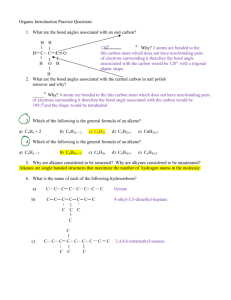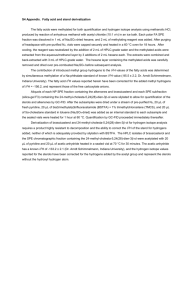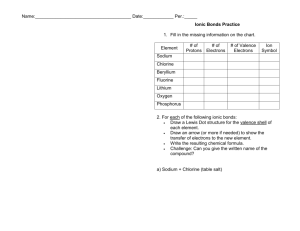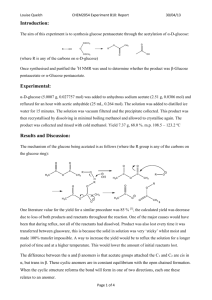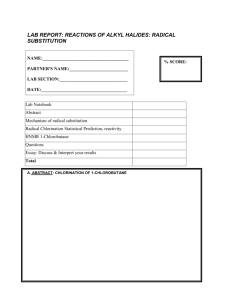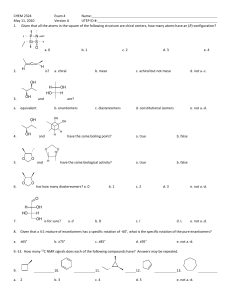Experiment #2
advertisement
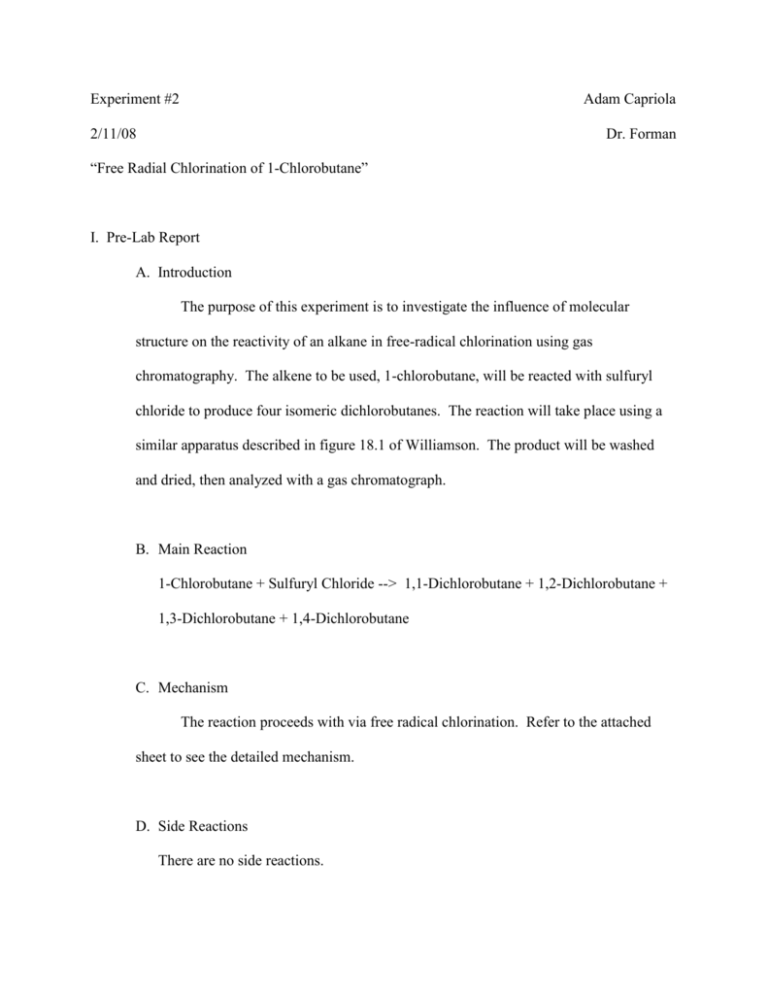
Experiment #2 Adam Capriola 2/11/08 Dr. Forman “Free Radial Chlorination of 1-Chlorobutane” I. Pre-Lab Report A. Introduction The purpose of this experiment is to investigate the influence of molecular structure on the reactivity of an alkane in free-radical chlorination using gas chromatography. The alkene to be used, 1-chlorobutane, will be reacted with sulfuryl chloride to produce four isomeric dichlorobutanes. The reaction will take place using a similar apparatus described in figure 18.1 of Williamson. The product will be washed and dried, then analyzed with a gas chromatograph. B. Main Reaction 1-Chlorobutane + Sulfuryl Chloride --> 1,1-Dichlorobutane + 1,2-Dichlorobutane + 1,3-Dichlorobutane + 1,4-Dichlorobutane C. Mechanism The reaction proceeds with via free radical chlorination. Refer to the attached sheet to see the detailed mechanism. D. Side Reactions There are no side reactions. E. Table of Reactants and Product(s) Compound 1-Chlorobutane Sulfuryl Chloride Molecular Weight (g/mol) 92.568 134.97 Azobisisobutyronitrile 164.21 Grams Used (g) 0.432 0.27 Moles Used (mol) 4.6 x 10-3 2.0 x 10-3 Melting Point (ºC) -123 -54.1 Boiling Point (ºC) 79 69.1 0.004 2.5 x 10-5 103-105 ----- Hazards Irritant Corrosive, toxic, lachrymatory Toxic, flammable II. Post-Lab Report A. Experimental Procedure The experimental procedure was followed exactly as written. The only minor difference was that 6 mg of AIBN was used instead of the recommended 4 mg. Also, it was noted that during washing, there was a bubble in the organic layer which may have caused error. B. Observed Yield of Product Tared vial: 11.568 g Tared vial with organic product: 11.648 g Organic product recovered: 0.080 g C. Calculations 7.8% 1,1-dichlorobutane / 2 H = 3.9% per each primary H 22.7% 1,2-dichlorobutane / 2 H = 11.35% per each secondary H 44.4% 1,3-dichlorobutane / 2 H = 22.2% per each secondary H 25.1% 1,4-dichlorobutane / 3 H = 8.4% per each primary H Ratio of reactivity per hydrogen at C1 : C2 : C3 : C4 = 1 : 2.9: 5.7 : 2.2 D. Conclusions The mixture of isomeric dichlorobutanes contained 7.8% 1,1-dichlorobutane, 22.7% 1,2 dichlorobutane, 44.4% 1,3-dichlorobutane, and 25.1% 1,4-dicholorobutane. From this data, it was determined that the relative reactivities of the hydrogens found at C1, C2, C3, and C4 was 1 : 2.9 : 5.7 : 2.2. This seems to confirm that secondary hydrogens are more reactive than primary hydrogens. It also showed that the secondary hydrogens at C3, which were further away from the original chlorine found at C1, were more reactive then the hydrogens found at C2. The primary hydrogens found at C4 were more reactive than the primary hydrogens found at C1, which also suggests that the original chlorine at C1 lessened reactivity of the hydrogens near it. Compared to the given ratio of 5.0 : 3.8 : 1.0 for the reactivity of tertiary to secondary to primary hydrogens of normal alkanes, the expected reactivity of the hydrogens on C1, C2, C3, and C4 of n-butane would be 3(1.0) : 2(3.8) : 2.(3.8) : 3(1.0), which simplifies to 1.0 : 2.5 : 2.5 : 1.0. Compared to the findings in the lab, the found ratio again hints that the original chlorine at C1 made the other primary hydrogens found at C1 and any hydrogens adjacent to it less reactive than expected.
